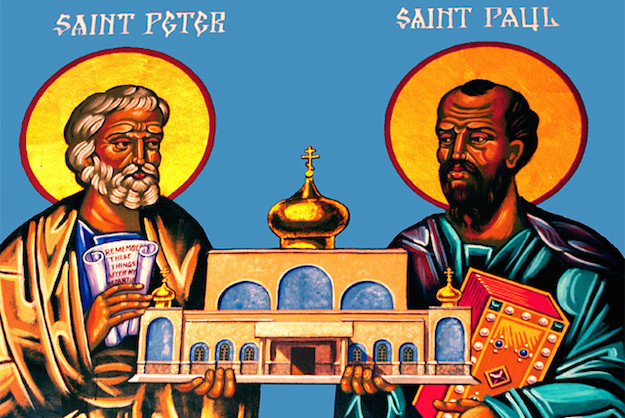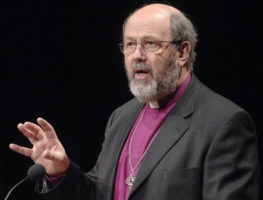It wouldn’t take much for me to try and convince you that St. Paul was a dividing figure. He got in Peter’s face – in public! He kind of trashed-talked Demas. Oh yeah, and he probably used air-quotes when talking about “the so-called pillar apostles.” He wasn’t quite a lone ranger apostle, but he was a figure that worked on the margins and stirred up trouble and controversy. From Galatians, we get a sense that he had an independent ministry, separate from the Jerusalem leadership (Peter will go the circumcised, and Paul to the uncircumcised). Paul shook hands with the “pillars,” but he worked separately from them.
As we think about the importance of “unity” in the biblical tradition, we tend to think of texts like John 17 – Jesus obviously believed in unity. But what about Paul? Did he have a vision for the one-ness of the people of God? I believe he did, and I believe it was both a priority for him as well as a source of controversy. Let’s look at Romans 14-15. In Rome, in Paul’s time, we get the impression that there was a kind of collective Christian community, but regular worship happened in house-churches. And house-groups probably formed naturally according to things like friendship groups and worship-preferences.
Sound familiar? Don’t we, today, shop around for a church that has people just like us and that “fits” our style of worship and community? (Fashion, music, building-type…coffee!) And, much like the Roman house churches, there is a kind of “live-and-let-live” mentality amongst churches today. We don’t mind that there is a church down the street, but God forbid we interact with them, much less worship with them! No doubt Roman house-groups were content to keep to themselves. Sticking close to your subculture, your little faith community, was normal at that time.
Paul encourages the Romans, though, to do two very uncomfortable things. First, he tells them to welcome the other (Rom 14:1). That doesn’t mean just Facebook-friend-ing a local fellow pastor or following her on Twitter. Paul explains: welcome the other as Christ welcomed you (15:7). Uh-oh. We kinda suck at that. By welcome Paul means go out and actively embrace the other. What would it look like for two nearby churches (even of different denominations! Yikes!) to embrace one another?
Secondly, Paul says build one another up. To put it in simpler term, do whatever it takes to make the other stronger. Now I know what you may be thinking. Some churches want to “make the other stronger” by tearing down their “faulty doctrine.” But look carefully at what Paul says – “Each of us must please our neighbor” (15:2). There is a time and a place for “tough love,” but that is not what Paul is saying here. We must learn and seek to make the other stronger in a way they will recognize and appreciate. Paul wanted to be a builder, not a wrecker. He did believe in unity after all.
We think of the first century as such an alien and foreign world –and it was. But micro-groups (house churches in their time) were just as susceptible to parochialism as we are in our time. Paul did not broadcast the message let us preserve our doctrine and build up walls to protect the truth. He did love the truth (Gal 2:14) and he did promote right-believing (Titus 2:1), but he made mutual upbuilding a serious priority (1 Cor 8:1).
So, when we think of St. Paul the “theologian,” I hope we will also remember St. Paul “the builder.”
Now go and make someone else stronger through your love.







Missio Alliance Comment Policy
The Missio Alliance Writing Collectives exist as a ministry of writing to resource theological practitioners for mission. From our Leading Voices to our regular Writing Team and those invited to publish with us as Community Voices, we are creating a space for thoughtful engagement of critical issues and questions facing the North American Church in God’s mission. This sort of thoughtful engagement is something that we seek to engender not only in our publishing, but in conversations that unfold as a result in the comment section of our articles.
Unfortunately, because of the relational distance introduced by online communication, “thoughtful engagement” and “comment sections” seldom go hand in hand. At the same time, censorship of comments by those who disagree with points made by authors, whose anger or limited perspective taints their words, or who simply feel the need to express their own opinion on a topic without any meaningful engagement with the article or comment in question can mask an important window into the true state of Christian discourse. As such, Missio Alliance sets forth the following suggestions for those who wish to engage in conversation around our writing:
1. Seek to understand the author’s intent.
If you disagree with something the an author said, consider framing your response as, “I hear you as saying _________. Am I understanding you correctly? If so, here’s why I disagree. _____________.
2. Seek to make your own voice heard.
We deeply desire and value the voice and perspective of our readers. However you may react to an article we publish or a fellow commenter, we encourage you to set forth that reaction is the most constructive way possible. Use your voice and perspective to move conversation forward rather than shut it down.
3. Share your story.
One of our favorite tenants is that “an enemy is someone whose story we haven’t heard.” Very often disagreements and rants are the result of people talking past rather than to one another. Everyone’s perspective is intimately bound up with their own stories – their contexts and experiences. We encourage you to couch your comments in whatever aspect of your own story might help others understand where you are coming from.
In view of those suggestions for shaping conversation on our site and in an effort to curate a hospitable space of open conversation, Missio Alliance may delete comments and/or ban users who show no regard for constructive engagement, especially those whose comments are easily construed as trolling, threatening, or abusive.